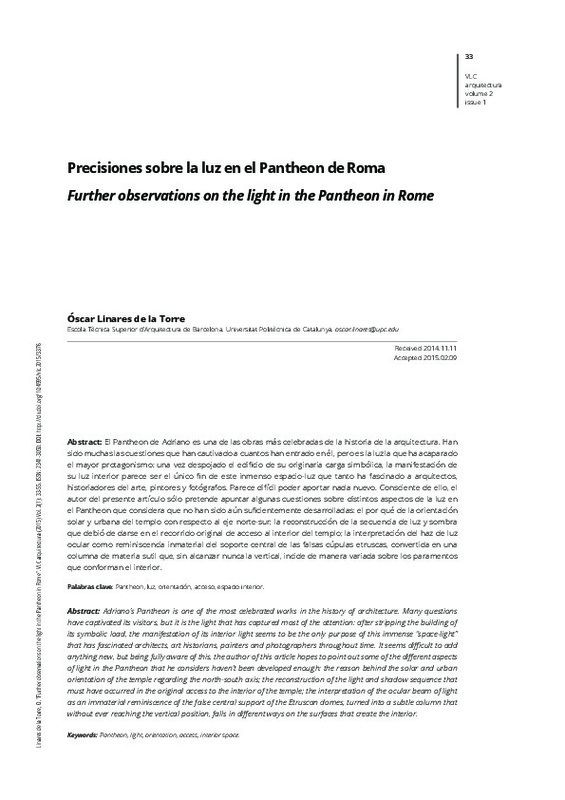JavaScript is disabled for your browser. Some features of this site may not work without it.
Buscar en RiuNet
Listar
Mi cuenta
Estadísticas
Ayuda RiuNet
Admin. UPV
Further observations on the light in the Pantheon in Rome
Mostrar el registro sencillo del ítem
Ficheros en el ítem
| dc.contributor.author | Linares de la Torre, Oscar
|
es_ES |
| dc.coverage.spatial | east=12.476840042293361; north=41.89890711710567; name=Piazza della Rotonda, 11, 00186 Roma RM, Itàlia | |
| dc.date.accessioned | 2015-05-06T11:37:07Z | |
| dc.date.available | 2015-05-06T11:37:07Z | |
| dc.date.issued | 2015-04-17 | |
| dc.identifier.issn | 2341-3050 | |
| dc.identifier.uri | http://hdl.handle.net/10251/49775 | |
| dc.description.abstract | [EN] Adriano’s Pantheon is one of the most celebrated works in the history of architecture. Many questions have captivated its visitors, but it is the light that has captured most of the attention: after stripping the building of its symbolic load, the manifestation of its interior light seems to be the only purpose of this immense “space-light” that has fascinated architects, art historians, painters and photographers throughout time. It seems difficult to add anything new, but being fully aware of this, the author of this article hopes to point out some of the different aspects of light in the Pantheon that he considers haven’t been developed enough: the reason behind the solar and urban orientation of the temple regarding the north-south axis; the reconstruction of the light and shadow sequence that must have occurred in the original access to the interior of the temple; the interpretation of the ocular beam of light as an immaterial reminiscence of the false central support of the Etruscan domes, turned into a subtle column that without ever reaching the vertical position, falls in different ways on the surfaces that create the interior. | es_ES |
| dc.description.abstract | [ES] El Pantheon de Adriano es una de las obras más celebradas de la historia de la arquitectura. Han sido muchas las cuestiones que han cautivado a cuantos han entrado en él, pero es la luz la que ha acaparado el mayor protagonismo: una vez despojado el edificio de su originaria carga simbólica, la manifestación de su luz interior parece ser el único fin de este inmenso espacio-luz que tanto ha fascinado a arquitectos, historiadores del arte, pintores y fotógrafos. Parece difícil poder aportar nada nuevo. Consciente de ello, el autor del presente artículo sólo pretende apuntar algunas cuestiones sobre distintos aspectos de la luz en el Pantheon que considera que no han sido aún suficientemente desarrolladas: el por qué de la orientación solar y urbana del templo con respecto al eje norte-sur; la reconstrucción de la secuencia de luz y sombra que debió de darse en el recorrido original de acceso al interior del templo; la interpretación del haz de luz ocular como reminiscencia inmaterial del soporte central de las falsas cúpulas etruscas, convertida en una columna de materia sutil que, sin alcanzar nunca la vertical, incide de manera variada sobre los paramentos que conforman el interior. | es_ES |
| dc.language | Español | es_ES |
| dc.language | Inglés | en_EN |
| dc.publisher | Editorial Universitat Politècnica de València | es_ES |
| dc.relation.ispartof | VLC arquitectura. Research Journal | |
| dc.rights | Reconocimiento - No comercial (by-nc) | |
| dc.subject | Pantheon | es_ES |
| dc.subject | Light | es_ES |
| dc.subject | Orientation | es_ES |
| dc.subject | Access | es_ES |
| dc.subject | Interior space | es_ES |
| dc.subject | Luz | es_ES |
| dc.subject | Orientación | es_ES |
| dc.subject | Acceso | es_ES |
| dc.subject | Espacio interior | es_ES |
| dc.title | Further observations on the light in the Pantheon in Rome | es_ES |
| dc.title.alternative | Precisiones sobre la luz en el Pantheon de Roma | es_ES |
| dc.type | Artículo | es_ES |
| dc.date.updated | 2015-05-06T10:49:11Z | |
| dc.identifier.doi | 10.4995/vlc.2015.3376 | |
| dc.rights.accessRights | Abierto | es_ES |
| dc.description.bibliographicCitation | Linares De La Torre, O. (2015). Further observations on the light in the Pantheon in Rome. VLC arquitectura. Research Journal. 2(1):33-55. https://doi.org/10.4995/vlc.2015.3376 | es_ES |
| dc.description.accrualMethod | SWORD | es_ES |
| dc.relation.publisherversion | https://doi.org/10.4995/vlc.2015.3376 | es_ES |
| dc.description.upvformatpinicio | 33 | es_ES |
| dc.description.upvformatpfin | 55 | es_ES |
| dc.type.version | info:eu-repo/semantics/publishedVersion | es_ES |
| dc.description.volume | 2 | |
| dc.description.issue | 1 | |
| dc.identifier.eissn | 2341-2747 | |
| dc.description.references | Deleuze, G. El pliegue. Leibniz y el barroco. Barcelona: Paidós, 1898 | es_ES |
| dc.description.references | Giedion, S. El Presente eterno: los comienzos de la arquitectura. Madrid: Alianza, 1981 | es_ES |
| dc.description.references | Hatecoeur, L. Mystique et Architecture: Symbolisme du cercle et de la coupole. Paris: A. et J. Picard et Cie, 1954 | es_ES |
| dc.description.references | Lanciani, R. Forma Urbis Romae, Quasar, Roma, 1990 | es_ES |
| dc.description.references | Macdonald, W. L. The Pantheon: design, meaning and progeny. Cambridge: Harvard University Press, 1976 | es_ES |
| dc.description.references | Miguel Arbonés, E. La Luz en la configuración del espacio. Tesis doctoral, Universidad Politécnica de Madrid, 2006 | es_ES |
| dc.description.references | Montero Fernández, F.J. El Panteón: Imagen, Tiempo y Espacio. Proyecto y Patrimonio. Sevilla: Universidad de Sevilla, 2004 | es_ES |
| dc.description.references | Stamper, J. W. The Architecture of Roman temples: the republic to the middle empire. Cambridge: Cambridge University Press, 2005 | es_ES |








